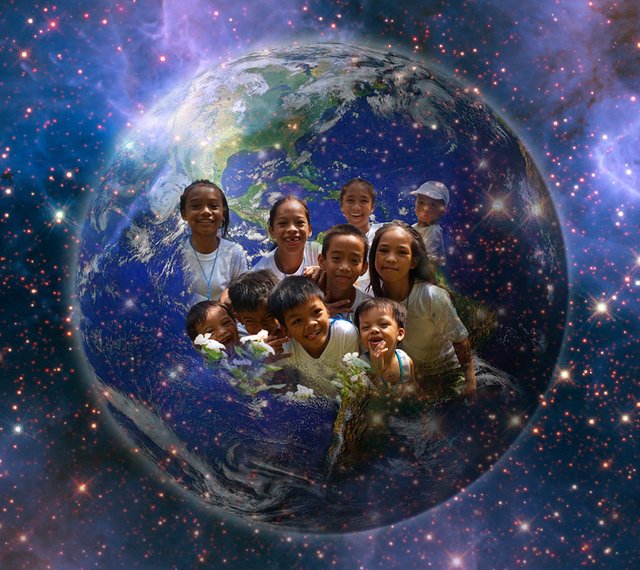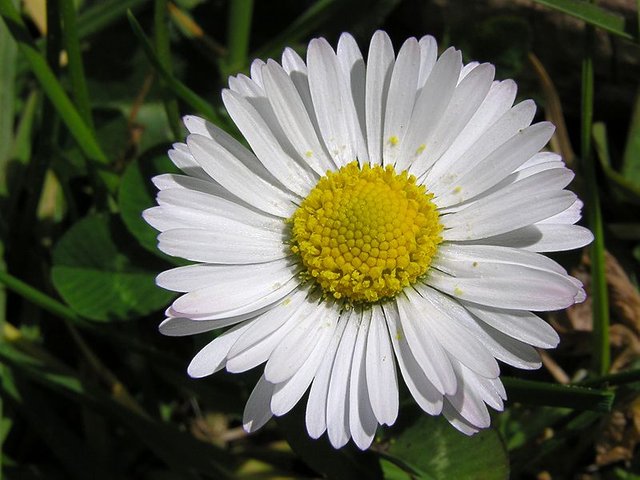Gaia Humanity
Long ago I fell in love with the ideas of James Lovelock, especially for his Gaia Hypothesis. In it he proposes that all organic life interacts with its inorganic, lifeless surroundings to create a balanced system that develops and maintains the conditions for life to perpetuate.

image by spirit111 - source: Pixabay
Just the idea of it is beautiful in my mind; to see the whole planet as one big living organism. And why stop there? Why not see the entire universe as a very complex system of interacting bodies, on an unimaginable scale, that pops out now and then, here and there, a place where life can thrive? James Lovelock formulated his hypothesis in the late 1960s when he worked for NASA on methods to detect life on Mars:
"First formulated by Lovelock during the 1960s as a result of work for NASA concerned with detecting life on Mars, the Gaia hypothesis proposes that living and non-living parts of the Earth form a complex interacting system that can be thought of as a single organism. Named after the Greek goddess Gaia at the suggestion of novelist William Golding, the hypothesis postulates that the biosphere has a regulatory effect on the Earth's environment that acts to sustain life.
While the Gaia hypothesis was readily accepted by many in the environmentalist community, it has not been widely accepted within the scientific community. Among its most prominent critics are the evolutionary biologists Richard Dawkins, Ford Doolittle, and Stephen Jay Gould, a convergence of opinion among a trio whose views on other scientific matters often diverge. These (and other) critics have questioned how natural selection operating on individual organisms can lead to the evolution of planetary-scale homeostasis."
source: Wikipedia
I hope you noticed the many apparent contradicting terms are being meshed together here. Life versus lifeless. Organic versus inorganic. And "natural selection operating on individual organisms" versus "the evolution of planetary-scale homeostasis". Lovelock shows us, with his Gaia theory, that these contradictions need not exist at all, which is something I have believed for as long as I can remember.
Lovelock set out to tackle the concerns from his fellow scientists and in the 1980s he developed the Daisyworld parable or simulation, a mathematical model to sustain his Gaia hypothesis. In the model a planet starts cold and without life. When the strength of the sun's rays are gradually increased, the surface eventually reaches a temperature for black daisies to emerge into existence. Their black leaves absorb the sunlight to further heat up the surface. Here's the full cycle, as lifted from Wikipedia:
"Because black daisies absorb more of the sun's radiant energy, they are able to increase their individual temperatures to healthy levels on the still cool surface of Daisyworld. As a result, they thrive and the population soon grows large enough to increase the average surface temperature of Daisyworld.
As the surface heats up, it becomes more habitable for white daisies, whose competing population grows to rival the black daisy population. As the two populations reach equilibrium, so too does the surface temperature of Daisyworld, which settles on a value most comfortable for both populations.
In this first phase of the simulation we see that black daisies have warmed Daisyworld so that it is habitable over a wider range of solar luminosity than would have been possible on a barren, gray planet. This allowed growth of the white daisy population, and the two populations of daisies are now working together to regulate the surface temperature.
The second phase of the simulation documents what happens as the sun's luminosity continues to increase, heating the surface of Daisyworld beyond a comfortable range for the daisies. This temperature increase causes white daisies, who are better able to stay cool because of their high albedo or ability to reflect sunlight, to gain a selective advantage over the black daisies. White daisies begin replacing black daisies, which has a cooling effect on Daisyworld. The result is that Daisyworld's surface temperature remains habitable - in fact almost constant - even as the luminosity of the sun continues to increase.
In the third phase of the simulation, the sun's rays have grown so powerful that soon even the white daisies can no longer survive. At a certain luminosity their population crashes, and the barren, gray surface of Daisyworld, no longer able to reflect the sun's rays, rapidly heats up.
At this point in the simulation solar luminosity is programmed to decline, retracing its original path to its initial value. Even as it declines to levels that previously supported vast populations of daisies in the third phase, no daisies are able to grow because the surface of barren, gray Daisyworld is still far too hot. Eventually, the sun's rays decrease in power to a more comfortable level which allows white daisies to grow, who begin cooling the planet."
source: Wikipedia
What Is The Gaia Hypothesis? | Gaia Theory Explained
All this has made me think: why not apply this principle to humanity? If all individual daisies form a system to regulate the temperature on a living planet, individual humans form a system, society, to regulate the "temperature" within that society. Because collectivism and individualism are prominent polar opposites in many modern people's minds, when they don't need to be. Collectivism is "the practice or principle of giving a group priority over each individual in it" , while individualism is the exact opposite of that. Why is it so difficult to just place both the collective and the individual on equal footing? It's true that in my posts I mostly argue for the collectivist point of view, but I do this consciously and with good reason.
Our form of consumer capitalism is all about the individual. I can clearly point to the time in history when the individual became the be-all and end-all, and I can name names to: Friedrich Hayek said that any amount of "social welfare" policy could be labeled fascist, simply because both are collectivist ideas. Reagan and Thatcher united forces to promote the idea of laissez-faire market economy to the degree that Thatcher even said "there’s no such thing as society, there are individual men and women."
Why, I ask myself. Why do we accept these dichotomies that aren't dichotomies at all? We are individuals and we are part of many collectives. The smallest being the family and the ultimate being humanity, the planetary collective. We live in a wonderful, experimental era in which technology has given us the chance to, for the first time in human existence, truly experience what happens when scores of totally different individuals from all over the globe come together on the internet to share their individual ideas, opinions and experiences.
Could we be present at the birth of some sort of collective consciousness, a global brain, made tangible through this interconnectiveness of individual minds? The internet doesn't coerce us to give up on our individuality; the biggest fear modern liberals seem to have when collectivist ideologies are discussed. And maybe that fear is justified under the current definition of collectivism, where the group is placed above the individual. But I know, because I have eyes, ears and a brain, that doing the reverse, what these modern liberals do, leads to all kinds of plutocratic and fascist politics.

one individual white daisy - source: Wikimedia Commons
The dichotomy dissolves when thinking about the Gia hypothesis and Lovelock's black and white daisies. How I see it is that we are all individuals because we derive that individuality from the collective we are born from. And in turn our individuality adds to the richness of that collective. We are all different because of our individual perspective on the reality we shape collectively. Collectivism and individualism are two sides of the same coin and are therefore eternally unified...
NASA | This World Is Black and White
The above is a redacted version of a post I originally released on Steemit in July, 2018
Thanks so much for visiting my blog and reading my posts dear reader, I appreciate that a lot :-) If you like my content, please consider leaving a comment, upvote or resteem. I'll be back here tomorrow and sincerely hope you'll join me. Until then, stay safe, stay healthy!

Recent articles you might be interested in:
| Latest article >>>>>>>>>>> | Disconnect |
|---|---|
| Amazing Ancient Structures | Gap In The Middle |
| What's Left? | Rock-Bottom |
| Stan Lee On Racism | Right Now |

Thanks for stopping by and reading. If you really liked this content, if you disagree (or if you do agree), please leave a comment. Of course, upvotes, follows, resteems are all greatly appreciated, but nothing brings me and you more growth than sharing our ideas.
You've got a free upvote from witness fuli.
Peace & Love!